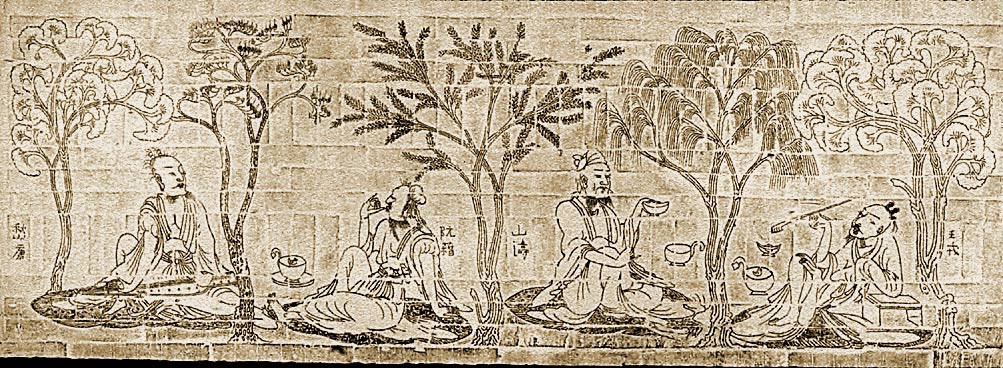Graham James Chamness, Ph.D. candidate in East Asian Languages and Civilizations at Harvard University and Fairbank Center Graduate Student Associate, examines Confucian ideas of friendship in China’s pre-modern past.

As with so many things, we do well to turn to Confucius as a starting point for understanding the importance of friendship in Chinese cultural history. “Friends,” in literary Chinese péng 朋, or more commonly yǒu 友 — whence we derive the modern Chinese word péngyǒu 朋友 — make frequent appearances throughout the Analects, the collection of sayings attributed to the Master. In the Analects, Confucius is more often than not found surrounded by disciples, who sometimes look more like friends than students.
But the Master also spoke in certain terms about friendship. The first passage of that collection, one of the most memorized passages of all Chinese literature, specifies how we should feel when a friend visits us from afar: “surely it is delightful!” For Confucius, it was not simply natural to enjoy the company of others; taking delight in receiving friends also constituted part of what it meant to be a “gentleman,” a paragon of social and moral virtue. And to this day, when a Sinophone friend pays you a visit, it is your amical duty to feast that friend, arrange for door-to-door transportation, provide entertainment, and attend to that person’s needs at your expense. Most importantly, all of this of course is your pleasure, your delight, without a hint of violating that Confucian injunction.

The upshot of hosting a friend the Chinese way is that you can rest assured you will receive the same treatment when the situation is reversed. But the picture becomes more complicated when we look at the realities of friendships as they manifested in pre-modern China. Even Confucius admits a more complex vision of the difficulties of making friends; he also said that a gentleman does not befriend others who are “not as good as himself” (bu ru ji zhe 不如己者). That is, the gentleman’s friendship circle should contain only people of equal or greater quality, but none inferior to him. Setting aside the problem of how to measure quality in a friend, how are we supposed to realize this ideal? As one early commentator on the Analects wrote, “if we all aspire to befriend people who are better than ourselves, why would those people want to befriend us?”
A partial answer to this question involves the prescriptive notion of shared intentionality: we should befriend people who share the same intentions as us. Discussions of friendship in China are thus inseparable from discussions of the moral intentionality of individuals. The Chinese terms for this were tongyi 同意 or tongzhi 同志, which give us the modern words for “agree” and “comrade,” although a better translation for their pre-modern sense would be “like-minded” or “shared intention.” As Anna Shields demonstrates in her book, One Who Knows Me: Friendship and Literary Culture in Mid-Tang China, such an emphasis on mutual understanding among friends coexisted with other instrumental uses of friendship. This was especially true in the fourth century, when friendship circles came into another kind of prominence and achieved a new cultural prestige as the power of the literary elite grew vis-à-vis a weakened central government of the Eastern Jin dynasty (317–420).
Fourth-century friendships are often difficult to see — there is only so much of the written record that survives from such early times. But one of the places where we see them in action is in second-hand accounts of elite social gatherings. On these occasions, which often took place on the grounds of local monasteries, administrative buildings, scenic sites, or private villas, the elite (generally male) literati would compete by demonstrating their quick wit in conversations on topics of history, philosophy, and religion. In other words, social gatherings were used by the elite to demonstrate their own “minds” (yi) and sometimes to create groups of “like-minds” (tongyi). What’s surprising, however, is that in most cases the actual content of these conversations was not transmitted; rather, the names of the literati and value judgments on the quality of their speech are what others passed down in word and in writing.

Being included in the elite like-minded group provided a means of elevating one’s own status in fourth-century China; for by participating in group gatherings one’s name could be recorded alongside those of other famous literati. One of the iconic models of such like-mindedness was the Seven Worthies of the Bamboo Grove (Zhulin qixian 竹林七賢). This particular group identity consisted of seven third-century elites who would supposedly meet together in a bamboo grove and drink to their hearts’ content; their like-mindedness went so far that they had no use for conversing at all. The fourth-century literati debated whether all seven deserved to be included within the group. The issue was not whether they all knew each other (although this is in fact far from clear), but that two of the seven compromised their lofty principles, or “minds,” by serving the new, corrupt government. A major compliment in the fourth century was to tell someone that he was worthy to be admitted into the “bamboo grove.”

The Seven Worthies are an extreme example of a like-minded group identity imagined in a space beyond the world of public office. However, the most famous group from the fourth century is undoubtedly the friends and relatives of the calligrapher Wang Xizhi 王羲之 (303–361). On April 22, 353, Wang Xizhi hosted a spring gathering of forty-two participants on the grounds of the precinct house Lanting 蘭亭 (sometimes rendered as “Orchid Pavilion”) in Shaoxing.
The participants at Lanting played a drinking game, floating cups of ale on bending waters, and composed poems ex tempore. Those who failed to compose were penalized by being forced to drink three cupfuls of ale each. Although the festivities lasted for at most several hours, we see in the poems that survive from the event that the friends of Wang Xizhi fashioned themselves as a like-minded group whose identity would extend beyond the limits of their time and place. They imagined themselves in momentary repose beyond the world of public office; the model for their group was another spring gathering of Confucius and his disciples. Just as Confucius and his disciples had gathered in late spring and expressed their intentions to enjoy a moment of leisure on the banks of the Yi River, Wang Xizhi and his disciples styled themselves as leisurely strolling to Lanting and sharing in seasonal festivities and drink. Whereas such banquets had been used for large state-sanctioned gatherings of officials before, here Wang Xizhi and his friends were promoting their own group identity outside officialdom.

Friendship seems to imply a non-hierarchical relationship among equals, as opposed to mother-daughter, master-disciple, and so on. But this was often not the case. Instead we see the discourse of friendship, i.e. non-hierarchical relations, mapped onto pre-existing father-son, elder-younger, master-disciple, and other hierarchically marked relationships. For example, generation gaps and major differences of reputation existed between the Seven Worthies; and Wang Xizhi’s sons and in-laws are conspicuously figured into the Lanting group. In fourth-century China, the notion of a friendship bond was often evoked to cover up those distinctions as well as to elevate the status of male literati by association with other well-known elites. Friendship — more specifically publicizing friendship — was thus both central to maintaining group identities among non-equals and instrumental for achieving recognition and fame.
This is an unfairly brief sketch of just some of the complexities that underlie friendship circles, group identities, and literati gatherings in fourth-century China. Moreover, it would be impossible to disentangle all the questions of motivation, genuineness, and self-representation regarding the way friends are portrayed in our sources. But it bears noting: the relationship between friendship activities and the non-courtly spheres in which they occur, real or imagined, is not accidental. If it is true that these activities happen in a sphere outside the world of official service, then it is also true that these activities are responsible for generating that sphere in some sense. Friends, then, have a way of shaping the realities we live in.
Graham James Chamness is a Ph.D. candidate in East Asian Languages and Civilizations at Harvard University and a Fairbank Center Graduate Student Associate.


